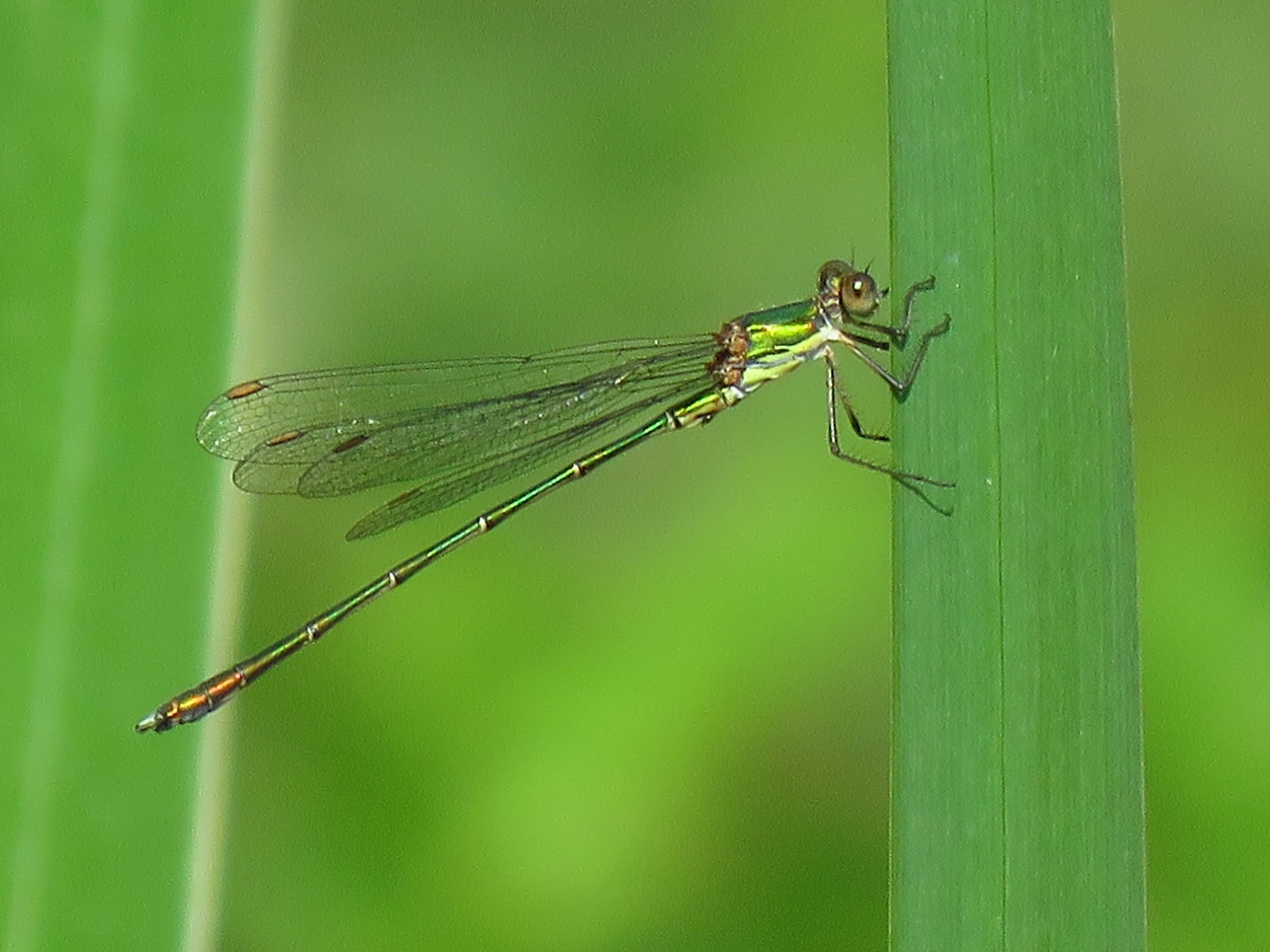#6 Willow Emerald by Africa Gómez
Meet Africa Gómez, lecturer in Biology at the University of Hull!
Dr Africa Gómez is a lecturer in Biology at the University of Hull. She’s been interested in natural history for as long as she can remember. She’s an enthusiastic biological recorder, mainly of birds, butterflies and dragonflies, and is involved in several regular volunteer surveys for the BTO, always with a strong urban focus. She keeps several blogs including Wild at Hull and Bugblog illustrated with her own photographs. In 2019 and 2020, together with Dick Shillaker, Africa organised ‘Hull Dragons’, a project to record the dragonflies and damselflies of Hull and the surrounding area. It was a hugely successful project, contributing over 1500 dragonfly records to iRecord. You can contact her via email at a.gomez@hull.ac.uk, and find her at @abugblog on Twitter and on LinkedIn.
Africa’s chosen species is the Willow Emerald Damselfly Chalcolestes viridis. The Willow Emerald is a relatively large, metallic green damselfly that inhabits still or slowly flowing waters with overhanging trees, including rivers, ditches, ponds lakes and canals, often in urban environments. It is unusual amongst damselflies in that it lays eggs in tree branches overhanging water and also that is a late flying species, present from August until October. It basks on leaves and branches of trees and bushes near water with outstretched wings. A diagnostic feature is a dark green spur on the sides of the thorax. The eggs form gall-like scars on the branches of willows or alders over the water, which are also diagnostic for the species. Once they hatch, the larvae fall in the water, where they predate on small aquatic invertebrates, then emerge the following summer. You can find out more about this species on the NBN Atlas.
Though she has always been fascinated by them, Africa became particularly interested in dragonflies and damselflies in 2018, when she became a more dedicated recorder and member of the Yorkshire Dragonfly Group and British Dragonfly Society, recording all regular breeding species in Yorkshire. With a strong interest in urban ecology, dragonflies and damselflies were naturally interesting to her, being flagship groups in urban environments and relatively easy to observe and identify due to their size and behaviour. They’re also great species to engage the public with urban biodiversity for these very reasons, something Africa is passionate about.
Willow Emerald damselfly © Africa Gómez.
The Willow Emerald is a recent colonist in the UK, present since 2007 and still rapidly spreading North and West at an average rate of 15-20 km per year. The first Yorkshire records arrived in 2019, when the species moved north along the North Sea coast.
‘I first saw Willow Emeralds in a London park in 2019, only a few weeks before I saw my first Yorkshire individual. Given the rapid expansion of this species, the colonisation of Yorkshire was expected. Despite the predictability, I never cease to wonder how this small, apparently delicate insect travels long distances, including sea crossings, in search of new areas to colonise. I still find it very exciting to search for and discover new species in my local area, to identify suitable habitat, to get acquainted with the behaviour and natural history of a species.’
After Africa’s first Yorkshire sighting of the Willow Emerald on a Hull Dragons survey in East Park, Hull, the same year it was found at North Cave Wetlands and Harwood Dale in North Yorkshire. In 2020 the species was found again at Hull, on the Beverley and Barmston Drain, at Spurn, Wykeham, and Humber Bridge Country Park. By 2021, individuals appeared in several of the previously recorded locations, suggesting local breeding, and new sites were colonised across East Yorkshire. Recording effort is now incredibly important, as the species is probably under-recorded, but is likely to become an established, abundant species in Yorkshire due to a wealth of suitable habitats. Are you looking for insects to record after summer has passed? The Willow Emerald is perfect, notes Africa: ‘When summer is coming to an end, the Willow Emerald season is only starting, prolonging the joys of insect recording into the autumn.’
“I never cease to wonder how this small, apparently delicate insect travels long distances, including sea crossings, in search of new areas to colonise.”
A Willow Emerald damselfly pair engaged in a ‘mating wheel’ © Africa Gómez.
Interestingly, damselflies and dragonflies are bucking the awful trend of species declines in the UK. Although many species are suffering from the effects of intensive agriculture, pesticide use and habitat loss, global climate change is benefiting insects that thrive in warmer temperatures. Research based on 1.4 million records analysed and presented in the recently published ‘State of Dragonflies in Britain and Ireland’ report concludes that 41% of the UK species have increased their distribution range since 1970 with only 11% declining. The Willow Emerald had previously increased its range northwards in Europe, a trend that is illustrated by several species of dragonflies and damselflies, often Mediterranean or North African species that are spreading northwards as the climate warms. Although it is exciting to welcome all these new, often colourful species to the Yorkshire list, it is a strong, visible symptom of the warming of the climate.
Monitoring
The British Dragonfly Society and the Yorkshire Dragonfly Group will welcome any records of damselflies and dragonflies, including the Willow Emerald, to help tracking its spread across the country.
Acknowledgements and further information
NEYEDC would like to thank Africa for her time and expertise in helping to create this blog. For those interested, the City of Dragons 2019 report can be downloaded from the Yorkshire Dragonfly Group website. If you’d be interested in contributing a piece for the series, contact Lucy at lucy.baldwin@neyedc.co.uk. To find out more about biological recording, see the Naturalists page on our website.



